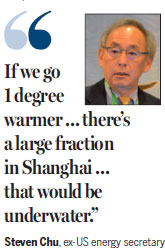Collaboration key on green energy, climate: experts
Updated: 2016-07-18 11:01
By Lia Zhu in San Francisco(China Daily USA)
|
||||||||
The US and China must work together in developing renewable energy and to battle climate change, said experts attending a green energy summit in Silicon Valley.
"China's rapid economic growth brought increasing pressure on the environment and air pollution, and the US led the world in green energy innovation," said Robert Wu, chairman of the US-China Green Energy Council. "We strongly believe the US and China working together is the golden key to address not only the shared issues of the two countries but also the global challenges."
Wu spoke at the 2016 Green Energy Summit in Santa Clara, California, on July 15, which was hosted by the Silicon Valley-based organization and attracted about 100 experts from China and the US.
The experts all agreed that the climate had been aggravated to an extent that concerted efforts had to be made to fight it. The US and China are the world's largest economies and polluters.
Steven Chu, former US secretary of energy, told the summit that the temperature had increased roughly 1 degree Celsius since 1880, and glaciers were melting.
"If we go 1 degree warmer, which is the UN goal (the United Nations aims to limit the increase by that amount per year) ... there's a large fraction in Shanghai and surrounding area that would be underwater," said Chu, showing a map of Shanghai's sea level.

A 6- to 9-meter rise of the sea level will likely create 500 to 700 worldwide climate refugees and tens of millions of people would be displaced in the Shanghai area alone, according to the map.
The solution for the potential risk is science and technology - energy efficiency in buildings, transportation, the industrial process and elsewhere, Chu said.
Reusable energy, primarily wind, water and solar, could meet 60 percent of the primary energy demand for both the US and China by 2050, Wu said.
The good news was that the price for the technology of solar and wind would continue to decline for perhaps another two decades, Chu said.
"For the next 20 years, you really can expect contracts for wholesale solar and wind being somewhere in the 2-3 cents KWH (kilowatt hours)," he said. "But you need an integrated system that can use these intermittent resources."
Long-distance transmission is another big deal, and China beat the world in the longest transmission, Chu said.
The country has installed about 60 GW (gigawatts) of high-voltage DC and AC lines, and by 2020, more than 2,000 GW will have been installed.
China just started building a 3,200-km 1.1 MV (megavolt) DC line, which loses only 5 percent of its energy while the vast majority of high-voltage lines in the US are below kV AC, and 85 percent of the power will be lost in a 500 kV line, according to Chu.
China leads the world in hydropower capacity, solar PV capacity, wind power capacity and solar water heating capacity, says the report. By the end of 2015, China had 199 GW of renewable power capacities, ranking the first in the world, which had 785 GW in total.
The US, helped by its high technology, got a handle on air pollution problems, particularly in Los Angeles, about 40 years ago. China has intense air pollution now and has a reason to implement high technology, said Jeffrey Ball, scholar-in-residence at Stanford University's Steyer-Taylor Center for Energy Policy and Finance.
"But the notion that China is simply a taker of American technology is increasingly an outdated notion. Quite sophisticated research and development are going on in China today," he said.
"There are actually self-interested reasons why both the countries want to collaborate," he said.
liazhu@chinadailyusa.com
(China Daily USA 07/18/2016 page2)
- 8-year-old boy gains 11kg to save father
- China rebuts claim it sank Vietnamese fishing boat
- China on high alert as floods kill 237
- What I want is a healthy grandson, so I will try anything I can
- China calls on US, Japan to stop twisting the facts
- Girl suffers sibling rivalry disorder after younger brother's birth
- African Union opens with launch of continental passport
- Baton Rouge shooter identified as ex-Marine Gavin Long
- Navy chiefs set for fresh talks on South China Sea
- Arrests hit 6,000 as Turkey cracks down on army and judges after coup bid
- A close look at Theresa May's new cabinet
- More than 70 dead in Nice attack as France marks national day

 The world in photos: July 11 - 17
The world in photos: July 11 - 17
 Ten photos from around China: July 8-14
Ten photos from around China: July 8-14
 The only surviving panda triplets weaned from milk
The only surviving panda triplets weaned from milk
 First sea-air emergency drill held near Sansha
First sea-air emergency drill held near Sansha
 Truck attack in Nice as France marks national day
Truck attack in Nice as France marks national day
 Picture Chinese stories: 10 illustration books you can't miss
Picture Chinese stories: 10 illustration books you can't miss
 Theresa May: New Iron Lady in Downing Street
Theresa May: New Iron Lady in Downing Street
 Large amount of sea grass besieges Qingdao
Large amount of sea grass besieges Qingdao
Most Viewed
Editor's Picks

|

|

|

|

|

|
Today's Top News
Ministry slams US-Korean THAAD deployment
Two police officers shot at protest in Dallas
Abe's blame game reveals his policies failing to get results
Ending wildlife trafficking must be policy priority in Asia
Effects of supply-side reform take time to be seen
Chinese State Councilor Yang Jiechi to meet Kerry
Chinese stocks surge on back of MSCI rumors
Liang avoids jail in shooting death
US Weekly

|

|